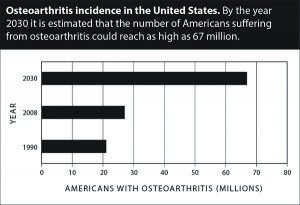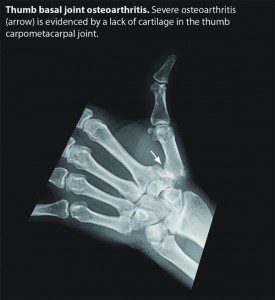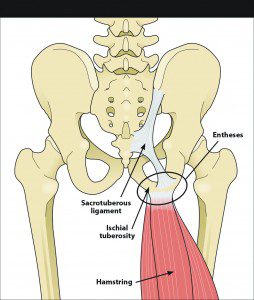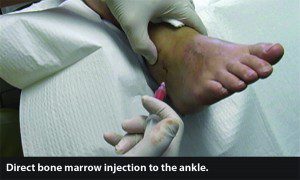Find Relief with Prolotherapy
By Debra K. Brinker, RN


Osteoarthritis is a debilitating joint condition that affects people around the world. In fact, it is the most common joint disease globally. Since it is so vast and pervasive, symptomatic osteoarthritis (OA) causes substantial physical and psychosocial disability. OA limits millions of people in their daily activities due to its characteristic symptoms of chronic pain and joint stiffness from damage to joint structures. In addition, there is a huge economic impact from hours of work lost and cost for surgery, rehabilitation, variable treatments, pain medications and disability. As the population increases, the number of those affected with arthritis also increases, making osteoarthritis a pressing individual and public health concern. [See Figure 1.]
Defining Osteoarthritis
Osteoarthritis results from a sequence of events that changes the structure and function of the joint. Although progressive cartilage loss with its inhibition of joint motion plays a central role in OA, injury to or failure of other joint structures actually initiates the change in equilibrium that leads to this breakdown of cartilage. Osteoarthritis almost always begins with ligament weakness or injury. Ligaments hold the bones


together, and along with healthy cartilage and other soft tissue, allow for smooth joint motion. When the ligaments are weak due to injury, the motion becomes uneven, putting stress on other areas of the joint, which causes one area of bone to bear additional weight on the articular cartilage. This uneven distribution expands with ongoing joint stress, weakening the ligaments further, and causing additional instability of the joint. The increase in abnormal weight distribution inside the joint leads to a breakdown of the articular cartilage which causes a loss of smooth gliding motion and limitations in joint function. The unstable bony surfaces continue to rub roughly and unevenly, causing bone loss. This bony loss leads to joint space narrowing, exposure of the underlying subchondral bone and precipitates a process of bone remodeling, in which the subchondral bone thickens. This accumulated or thickened bony overgrowth is called osteoarthritis. [See Figure 2.]
Diagnosing Osteoarthritis
Diagnosis of osteoarthritis is made after a thorough history and physical examination. Radiography can be utilized to confirm the presence of joint space narrowing and osteophytes, and to rule out the presence of other conditions.
What Is the Source of Pain in Osteoarthritis?
Interestingly, the pain in osteoarthritis is not coming from the cartilage! There are no nerve fibers or blood vessels in cartilage tissue, and therefore it is incapable of generating pain or inflammation or any of the symptoms commonly described with OA. Conversely, structures such as the ligaments, tendons and their insertion sites or entheses at the bone, are all highly innervated. [See Figure 3.]


The progressive joint failure involved in OA typically causes pain, but not everyone is symptomatic. When pain does arise, it generally occurs with activity and is relieved by rest. As the condition progresses, pain is present at rest, and is commonly experienced as a non-localized deep, aching pain accompanied by joint stiffness, eventually precipitating the curtailment of activity and function. Psychological distress is understandably another associated factor endured by those who suffer from osteoarthritis.
Prolotherapy and Stem Cell Therapy Target Repair at the Source of Injury
Prolotherapy, a regenerative injection therapy, targets the ligaments, tendons and their insertion sites, and has been shown to successfully alleviate pain and improve function. There have been a number of studies and controlled trials which have demonstrated the efficacy of dextrose prolotherapy, in relieving the pain of osteoarthritis. Dextrose prolotherapy involves the injection of a hyperosmolar dextrose solution into an injury site to elicit localized inflammation, which is the first step in healing the damaged area. The dextrose solution acts as a proliferant via the induction of local inflammatory and wound healing cascades, including fibroblast cells that make collagen, resulting in strengthening and repair of the injured joint structures. Prolotherapy offers benefits in terms of pain relief, regenerative properties, and cartilage repair for people affected by osteoarthritis.


In more advanced osteoarthritic conditions, a person’s own stem cells can be utilized to enhance the effects of dextrose Prolotherapy. Stem cells and growth factors are in abundance in our bone marrow, blood, and fat tissues. Injecting these cells into the degenerated joint supports chondrogenesis, which is the process by which cartilage is developed. [See Figure 4.]
Chronic pain from osteoarthritis is a complex and unique condition, affecting individuals and those they love. In a time when healthcare providers have limited options for effective OA treatment and pain resolution, Prolotherapy is a promising treatment option to aid in relief of pain, offering the opportunity for healing and return to function for those suffering from the chronic pain and disability of osteoarthritis.
Prolotherapy Specilaists
239-303-4546
www.CaringMedical.com
PROLOTHERAPY SPECIALISTS:
Ross A. Hauser, M.D.
Danielle R. Steilen-Matias, PA-C
Timothy L. Speciale, DO
 Southwest Florida's Health and Wellness Magazine Health and Wellness Articles
Southwest Florida's Health and Wellness Magazine Health and Wellness Articles

